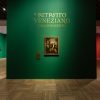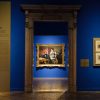THE NINETEENTH-CENTURY VENETIAN PORTRAIT
21 October 2023 – 01 April 2024
Venice, Ca’ Pesaro – International Gallery of Modern Art
Second floor exhibition rooms
Curated by Elisabetta Barisoni and Roberto De Feo
In collaboration with Gallerie dell’Accademia
In 1923, Nino Barbantini, the first director of Galleria d’Arte Moderna di Ca’ Pesaro, organised and staged a major exhibition dedicated to Il ritratto veneziano dell’Ottocento. The exhibition was a great success with the public and received an enthusiastic response from the press. Even today it is still considered a crucially important exhibition, which rediscovered an entire century of Venetian art, introduced many of its key artists and fostered appreciation for many of the masterpieces on display. The event also heralded a new direction for the Venetian Gallery and Barbantini’s work, which during the 1920s turned to planning major exhibitions on specific periods or individual Italian artists. Furthermore, Il ritratto veneziano dell’Ottocento remains a defining moment in the history of exhibitions and constitutes an influential, pioneering museological example of a show dedicated to a precise theme or time period.
The catalogue compiled by Barbantini includes 241 works by fifty artists, among them painters, sculptors and miniaturists, all of whom were active from first to the penultimate decade of the century, which for the specialist opens with Teodoro Matteini and closes with Giacomo Favretto. The list, organised in alphabetical order, not only presents brief biographies of the artists but also names the works’ respective owners at the time. This information was the initial source for the painstaking task of researching and identifying the works one hundred years after their exhibition at Ca’ Pesaro. Partly due to the success of the show, many works entered public collections, while others have remained with heirs or, to a lesser extent, have been permanently lost.
The exhibition at Ca’ Pesaro is a unique occasion for reconstructing the 1923 review, and revisiting numerous prominent personalities from the world of art, culture and society in a wide geographical area that extends from the capital of Veneto to Friuli Venezia Giulia. Not only Venice, but also Treviso, Bassano, Padua, Trieste, Belluno, Udine, Pordenone, Caneva di Sacile were among the places where the brilliant Barbantini was the first to discover works that represented the artistic greatness of a century, which had been neglected in order to mythologise the previous one.
Visitors had the opportunity to examine famous artists such as Hayez, Molmenti, Grigoletti, Schiavoni, Lipparini; artists discovered and rediscovered, who had lived and trained in Venice, leaving precious testimonies of the society, the spirit of the age, its protagonists and its great upheavals: a heritage of images of families, intellectuals, artists, patriots, women, some of whom themselves artists.
All this comes to life again today thanks to meticulous and lengthy research work conducted by the curators to reconstruct the layout and catalogue of the historic exhibition: this enormous critical effort over two years has led to the tracing of no less than 166 works by 52 artists from the original exhibition, now preserved in museums and collections throughout Italy. Alongside these are the masterpieces that have remained in Venice, drawn from the collections of Ca’ Pesaro, the Museo Correr, and the Gallerie dell’Accademia, together with numerous private collections. The reconstruction that has made it possible to develop significant new contributions concerning Barbantini’s project, including re-attributions – with 11 new recognised authors – and updated technical files – 279 for 60 artists – thanks to the work of a group of scholars, conservators and researchers from all over the territory.
In the four sections into which it is divided, the exhibition thus retraces The birth of a century, which starts with the Congress of Vienna (1815) and arrives after long ordeals at the unification of the country; significant monographic in-depth studies regarding The great protagonists, followed by Life and society in the nineteenth century, a mix of aristocracy and bourgeoisie, city and country; finally, The evolution of the portrait towards modernity, in which the pictorial matter is disassembled and develops new light, arriving at the turn of the twentieth century.
#Ritratto800
Visit to the exhibition with the Museum’s hours and ticket.
Discover the educational activities for the exhibition >







